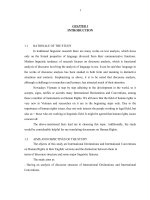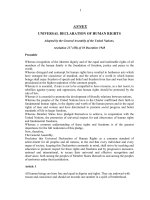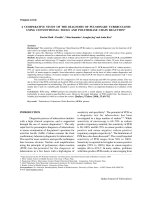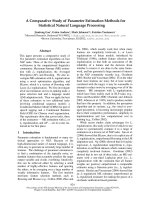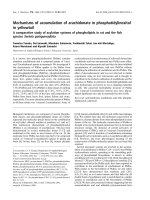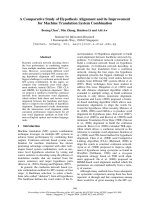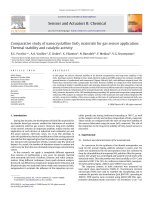A comparative study of feature selection methods for wind speed
Bạn đang xem bản rút gọn của tài liệu. Xem và tải ngay bản đầy đủ của tài liệu tại đây (851.59 KB, 10 trang )
TNU Journal of Science and Technology
227(07): 19 - 28
A COMPARATIVE STUDY OF FEATURE SELECTION METHODS FOR WIND SPEED
Nguyen Thi Hoai Thu*, Pham Nang Van, Nguyen Vu Nhat Nam, Pham Hai Minh, Phan Quoc Bao
Hanoi University of Science and Technology
ARTICLE INFO
Received: 21/01/2022
Revised: 19/4/2022
Published: 21/4/2022
KEYWORDS
Feature selection
Wind speed
Pearson’s Correlation
Random Forest
Boruta
ABSTRACT
Forecasting wind speed or capacity of wind power is playing an
important role to serve the problem of resource mobilization of the
power system. However, forecasting is still a difficult problem
because there are many factors affecting wind speed. In this paper, our
goals are using some feature selection methods to find the best
approach as well as to select the meteorological parameters that have
great influence on wind speed, thereby helping to improve our
predictive model. Pearson’s Correlation, Random Forest, Boruta were
3 feature selection methods to be used on 2 weather datasets in 2
different locations. Firstly, each data was analyzed with separate
autocorrelation and partial autocorrelation analysis. From this, the
hysteresis characteristics of the data were obtained then added to the
methods. Following that, we carried out and compared the
performance of the feature selection methods based on the evaluation
criteria of each method. The results show that the wind speed depends
heavily on the lags closest to it and in different geographical locations
gives different results.
MỘT NGHIÊN CỨU SO SÁNH
VỀ CÁC PHƯƠNG PHÁP LỰA CHỌN ĐẶC TRƯNG CHO VẬN TỐC GIĨ
Nguyễn Thị Hồi Thu*, Phạm Năng Văn, Nguyễn Vũ Nhật Nam, Phạm Hải Minh, Phan Quốc Bảo
Trường Đại học Bách khoa Hà Nội
THÔNG TIN BÀI BÁO
Ngày nhận bài: 21/01/2022
Ngày hồn thiện: 19/4/2022
Ngày đăng: 21/4/2022
TỪ KHĨA
Lựa chọn đặc trưng
Vận tốc gió
Phương pháp hệ số Pearson
Thuật tốn Random forest
Phương pháp Boruta
TĨM TẮT
Dự báo vận tốc gió hay cơng suất của điện gió đang là vấn đề được
quan tâm lớn hiện nay để phục vụ bài toán huy động nguồn của hệ
thống điện. Tuy nhiên, việc dự báo vẫn cịn gặp khó khăn do có rất
nhiều yếu tố ảnh hưởng tới vận tốc gió. Mục đích của bài báo này là
sử dụng các phương pháp lựa chọn đặc tính khác nhau để xem xét
ảnh hưởng của các yếu tố thời tiết tới vận tốc gió, từ đó cải thiện độ
chính xác cho việc dự báo vận tốc hay cơng suất gió. Các phương
pháp được đề cập đến là Pearson’s Correlation, Random Forest và
Boruta và được sử dụng trên hai tập dữ liệu thời tiết tại hai thành phố
khác nhau. Đầu tiên, chúng tôi sử dụng hàm tự tương quan và hàm
tương quan riêng để có thể xem xét tổng quan mối quan hệ giữa vận
tốc gió và các trễ của chính nó trong q khứ. Tiếp theo, các trễ có
ảnh hưởng lớn và trễ bậc nhất của các yếu tố thời tiết khác được sử
dụng làm đầu vào cho ba phương pháp lựa chọn đặc tính. Cuối cùng,
chúng tơi so sánh kết quả giữa các phương pháp với nhau. Kết quả
thu được cho thấy tốc độ gió phụ thuộc rất lớn vào chính nó ở các trễ
gần nhất.
DOI: />*
Corresponding author. Email:
19
Email:
TNU Journal of Science and Technology
227(07): 19 - 28
1. Introduction
Due to the energy crisis and environmental issues, renewable energy (RE) has attracted global
attention and becomes an alternative to fossil-based energy sources all over the world in the last
decade [1]. Among various kinds of RE resources, wind energy is one of the important RE
sources with the rapid development and significant penetration into power systems [2], [3].
However, the intermittency of wind power makes power system operation and control more
challenging [3]. To effectively integrate wind energy into systems, the wind speed (WS) and
wind power (WP) need to be accurately predicted.
In recent years, AI-based models are well developed and widely used for forecasting WS/WP.
However, when developing and applying these models, several following challenges have been
raising: (1) the complexity of models and (2) the volume of data [4]. WS/WP is usually predicted
based on its historical data and the meteorological data which are commonly represented by
extensive time series with multi-dimensions, data noises, and redundancy or lack of attributes.
Moreover, using a very complex AI-based forecasting model with a huge volume of input data to
train the model is not always feasible because of the limited calculation time and memory [5],
[6]. Therefore, approaches for reducing the number of features in the model to eliminate
extraneous and redundant data, avoid the loss of relevant information, and reduce computation
time are necessary. Feature selection (FS) is usually considered as an efficient solution for this
problem, which plays an important role in the data analysis process.
The basic feature selection method can be analyzed into 3 categories based on interaction with
the model machine: Filter, Wrapper, Embedded method [5]-[7]. In WS/WP forecasting, various
studies were conducted using a certain FS method to find out the features affecting the WS/WP to
improve the forecasting accuracy as well as decrease the computational cost. In [2], Jiang et al.
proposed a feature selection method using kernel density estimation (KDE)-based KullbackLeibler divergence (KLD) and energy measure to reduce the influence of the illusive
components. The original features include the subset of components after decompositions and
their lags. The results of the FS process provided the subseries with lags of 3 to 6 to conduct a
one-step prediction. Similarly, the optimal feature subset was selected from the combinations of
the original features which were constructed from all the intrinsic mode functions and the
residual after the decomposition of the wind speed series [3]. In other studies, the effects of
meteorological variables such as air temperature, wind direction, relative humidity, incoming and
reflected shortwave to the WS were considered using ReliefF method [8].
However, studies on the influence of weather parameters on the WP/WS have been still
limited. Generally, the FS for WS/WP was usually based on time series or decomposed series of
wind speed and their lags. Moreover, almost all studies have used only one method for FS
without comparison. Therefore, in this paper, we aimed at studying different FS methods for WS
to access the attributes of other meteorological parameters into the WS, find out the elements
which have a significant impact on WS. Additionally, a comparison analysis was carried out
using 2 weather datasets in Osaka (Japan) and Basel (Switzerland).
The paper is organized as follows. First, we briefly introduced different methods for FS in
section 2. We use 3 methods, namely Pearson Correlation (PC), Random Forest, and Boruta
which represented for 3 categories of Filter, Wrapper, Embedded methods, respectively. The
simulation results and discussions were presented in section 3. Finally, conclusions are drawn in
Section 4.
2. Feature selection methods
As mentioned above, Feature Selection (FS) is an important step in data analysis to improve
the accuracy of the model while reducing the computational burden and complexity of the model.
The basic feature selection methods can be classified into 3 types: Filter method, Wrapper
20
Email:
TNU Journal of Science and Technology
227(07): 19 - 28
method, and Embedded method. Filter method is based on the different characteristics of the data
to estimate and select a subset of the features, using evaluation measures extracted from the data
set, such as distance, information, dependency, consistency [9], [10]. The wrapper method needs
a machine learning algorithm and uses the performance of the algorithm as a benchmark for
evaluation. This method finds the features that are best to machine learning algorithms for the
purpose of improving data opening performance. This method uses predictive accuracy to
classify features. Some of the commonly used methods here are Forward Feature Selection,
Backward Feature Elimination, and Recursive Feature Elimination (RFE) [11]. Embedded feature
selection techniques are quite similar to Wrapper, based on different classifiers, predictors, or
clustering procedures. Some of the more commonly known methods include: L1(LASSO) [12],
Random Forest(RF) [13], [14] or Decision Tree algorithm [15]. Figure 1 shown the block
diagram of three methods of feature selection.
Figure 1. Block diagram of feature selection methods
2.1. Pearson’s Correlation (PC)
The Pearson's correlation coefficient is a measure of the linear relationship between two
interval- or ratio-level variables. Its value ranges from -1 to +1. The closer the value is to the
boundary, the higher the correlation. A positive value of the correlation coefficient indicates the
covariance of one variable with another. In contrast, a negative value of the correlation
coefficient gives the inverse among the analyzed variables. Values of the correlation coefficient
close to 0 mean that the variables have almost no correlation, and values close to -1 or +1
indicate a strong linear association between the two variables [16].
𝐶𝑜𝑣(𝑋, 𝑌)
𝐶𝑜𝑟(𝑋, 𝑌) =
(1)
√𝑉𝑎𝑟(𝑋)𝑉𝑎𝑟(𝑌)
Where Cov(X, Y) indicates the covariance of X and Y, Var(X) and Var(Y) denote the variance
of X and Y, respectively. Correlation methods such as the ones above will usually favor any
quantitative measurement performed on two or more variables simultaneously, the relationship
between the two variables is linear, and both must be analyzed. standard distribution. However, it
would be unwise to try to compute the correlation to a nonlinear relationship. In this paper, the
relationship between weather characteristics and wind speed is nonlinear.
2.2. Random Forest (RF)
Random forest is a supervised learning algorithm that can solve both regression and
classification problems. Random Forest algorithm builds many decision trees using the Decision
Tree algorithm, but each decision tree will be different (with random factor). The prediction
results are then aggregated from the decision trees. The weaknesses of the decision tree, whose
21
Email:
TNU Journal of Science and Technology
227(07): 19 - 28
results fluctuate considerably depending on the training data, are compensated for in continuous
learning and have a feature that focuses more on wrong answers from prior learning [15], [17].
In the Random forests algorithm used in this paper, we have 2 factors to consider calculating
model accuracy: Mean Decrease Accuracy (MDA) and Mean Decrease Gini (MDI). The MDI
assumes that the amount of impurity reduction when the individual variable is decided as the
partition node is the contribution in the random forests. Classification tree using Gini coefficient
index or information collection tree and regression tree using mean of variables to remove
impurities. The equation (2) calculates the importance of variable 𝑥𝑗 . To calculate variable
importance for the MDI method, it adds up the decrease of Gini index of each of the variables
from 1 to 𝑛𝑡𝑟𝑒𝑒 , which means the number of trees, and gets the average of all. MDA is a method
of calculating the significance of a variable by permutation and it uses Out-of-bag (OOB) to split
its sample data. With 𝑡 ∈ {1,2,3, … , 𝑛𝑡𝑟𝑒𝑒 }, the importance of the variable 𝑥𝑗 in the tree t is the
mean of the difference between the predicted class before the permuting 𝑥𝑗 , which is 𝑦𝑖 = 𝑓(𝑥𝑖 ),
𝑗
and after that, which is 𝑦𝑖 = 𝑓(𝑥𝑖 ), for a given observation I (Eq(3)).
𝑀𝐷𝐼(𝑥𝑗 ) =
𝑀𝐷𝐴(𝑥𝑗 ) =
1
𝑛𝑡𝑟𝑒𝑒
𝑛𝑡𝑟𝑒𝑒
1
𝑛𝑡𝑟𝑒𝑒
𝑛𝑡𝑟𝑒𝑒
[1 − ∑ 𝐺𝑖𝑛𝑖(𝑗)𝑘 ]
(2)
𝑘=1
∑𝑖∈𝑂𝑂𝐵 𝐼(𝑦𝑖 = 𝑓(𝑥𝑖 )) − ∑𝑖∈𝑂𝑂𝐵 𝐼(𝑦𝑖 = 𝑓(𝑥𝑖𝑗 ))
∑
|𝑂𝑂𝐵|
(3)
𝑡=1
2.3. Boruta
Boruta is the algorithm to be designed as a wrapper method that combines with the Random
Forest algorithm. The original data set is expanded by adding so-called drop shadows valuable
features are randomly swapped between training instances to eliminate correlation with a
decision variable. Estimating the significance of a calculated feature because of the loss of
classification accuracy caused by random permutations of feature values of cases. First and
foremost, the loss of classifier accuracy is calculated individually for all decisions trees in the
forest use a certain trait to classify cases, and then an average and the standard deviation of the
classification accuracy loss is calculated. An important measure is the Z-score calculated by
dividing the mean loss by its standard deviation. The importance measure is used to determine
the ranking of features [18]. The criterion for assessing the importance of this method is the Z
score can be written as Eq. (4).
𝑥−𝜇
𝑍=
(4)
𝜎
Where x is the raw score, μ is the population mean, and σ is the population standard deviation.
After calculating Z score for each feature, maximum Z-score (MZS) between the defined shadow
features and a specified hit for every feature that scores better than the MZS. The two-sided
equality test with MZS is applied. Features are important significantly lower than the MZS are
considered irrelevant (rejected). Features with significantly higher importance than MZS are
considered relevant (confirmed) features. The remaining features are treated as tentative ones.
3. Result and discussion
3.1.Case study
In general, for feature selection, a lot of meteorological data need to be used. The time series
should be at least 1 year to cover the possible seasonal characteristic. However, it is not necessary
to use too much data due to the time consuming and the difficulty in collecting data in a long
time. Moreover, the purpose of the study is to find out which parameters have the great impact on
wind speed, not the precise relationship between them. Therefore, in this study, we used the
22
Email:
TNU Journal of Science and Technology
227(07): 19 - 28
weather dataset of two regions: Basel and Osaka during 5 years from 2010 to 2014 [19], [20] to
determine the statistics of the characteristics that affected the wind speed. The weather
characteristics of Basel and Osaka are given in Table 1 and 2, respectively. While weather data
for Osaka is collected by the Japan Meteorological Agency (JMA), weather data for Basel is
collected by Meteoblue - a meteorological service created at the University of Basel, Switzerland,
in partnership with the US National Oceanic and Atmosphere Administration and the National
Center for Environmental Prediction located in Basel city. Both data are recorded hourly.
In this paper, the Autocorrelation Function (ACF) and Partial Autocorrelation Function
(PACF) functions are used to determine the lagging features of the wind speed itself in Basel and
Osaka, shown in Figure 2 and 3.
Figure 2 and 3 reveal information on the relationship of wind speed to itself at different lags.
First of all, Osaka's autocorrelation function oscillated gradually according to the exponential law
while with that of Basel, we couldn’t conclude yet, and these PACF plots showed that the partial
correlation function of Basel was the damped sine wave law while that of Osaka was the
exponential damping oscillation. In these partial correlation function plots, the wind speed of
Basel depended a lot on lag 1, lag 2, and lag 3 while that of Osaka depended almost on lag 1, lag
2. The reason why the ACF and PACF were to be considered is that these plots helped us to see
which wind speed lags had a great influence on itself at the time t. After filtering out the
important lags, they were combined with the first lag of other features to form a set of lagged
features and used the above methods to find the good ones.
Table 1. Descriptive statistics of raw historical weather data set of Osaka city from 2010 to 2014
Wind Hours
Solar
Pressure Air Temp. Dewpoint Humidity
speed sunlight radiation Cloudiness
(hPa)
(°c)
(°c)
(%)
(m/s) (h)
(MJ/m2)
Mean
1005.17
16.94
9.35
62.71
2.49
0.45
0.59
6.72
St.dev
6.7
8.95
9.57
15.93
1.42
0.43
0.89
3.64
Min.
971
-2.7
-14.2
10
0
0
0
0
Max.
1024
38.1
26.2
99
11.7
1
4.11
10
Table 2. Descriptive statistics of raw historical weather data set of Basel city from 2010 to 2014
Mean
St.dev.
Min.
Max.
Temp.
(°c)
[2 m]
11.78
7.68
-12.52
36.22
Humidity
(%)
[2 m]
72.36
14.95
17
100
Wind
Speed
(km/h)
10.62
7.87
0
74.34
Wind
Direction
(°) [10 m]
201.41
96.09
0.64
360
Cloud
Cover
Total
53
45.75
0
100
Solar
Radiation
(W/m2)
163.07
230.13
0
890.89
Direct
Radiation
(W/m2)
96.55
150.89
-9.07
605.12
Diffuse
Radiation
(W/m2)
66.52
86.6
0
302.04
Mean Sea
LevelPressure
(hPa)
1016.22
7.99
976.1
1040.5
(a)
b)
Figure 2. ACF plots of the wind speed: (a) Basel and (b) Osaka
23
Email:
TNU Journal of Science and Technology
227(07): 19 - 28
(a)
(b)
Figure 3. PACF plots of the wind speed in: (a) Basel and (b) Osaka
3.2. Comparision and discussion
To achieve our goals, we developed programs for the above methods using RandomForest
package in R which is an open-source software environment [21]. First, the correlation of wind
speed was calculated by running the program according to Pearson's correlation method and got
the result as shown in Figure 4. Except for the time features which are month, hour, and day, the
rest of the features were all considered lags because our goal was finding the relationship
between the wind speed at present and all the features in the past to be able to make accurate
forecasts. And feature month, hour, day to stay at the current time to be able to see if time has a
lot of influence on wind speed or not. Each of the past lags we denote by numbers, for example
solar radiation at the first lag and wind speed at the third lag are SR1 and WS3, respectively. It is
interesting that the wind speed in Osaka depended greatly on its first 7 lags, besides it was also
affected by humidity at first lag and solar radiation at first lag while that of Basel depended
almost entirely on its first 3 lags. But the correlation of wind speed lags from 13 to 25 was higher
than the rest of the other features, which points that wind speed at this city to be affected almost
by itself lags. However, if we compared the role of wind speed at first lag between the two cities,
the highest importance index in Osaka would have significantly lower than that of Basel. Part of
the reason is that in the data processing, Basel had no missing data while Osaka has quite a lot of
Na values.
After Pearson’s correlation was used, the second method is the Random Forest model to be
applied. The number of trees to grow in both data was 300. The reason why choosing this number
of trees to be used was that if less then there might not be enough volume to give a suitable result
while more could also lead to too large volume making it difficult during program running.
Besides, the number of variables randomly sampled as candidates at each split in Basel and
Osaka are 12 and 16, respectively. The effectiveness of the results were shown through two
criteria in Figure 5. Overall, the dependence of wind speed of both two cities had many similar
results of Pearson’s correlation. Considering the city of Basel, in the MDA and MDI charts, the
figure for the wind speed at first lag had the largest significant score far ahead of other features,
while that of wind speed at lags 2 and 3 had the next highest scores. Some other features that
24
Email:
TNU Journal of Science and Technology
227(07): 19 - 28
have high indexes in both two graphs were hour and temperature at first lag. And in Osaka city,
the figure for the wind speed at first lag appeared to be by far the largest score, which was
followed by that of solar radiation at first lag, wind speed at lag 2, and pressure station at first lag
in the MDA chart. Another striking feature in Osaka’s MDA chart is that the scores of Month and
Day were respectively 8 and 45 times smaller than the score of the wind speed in the first lag and
did not appear in the chart. In the MDI chart, wind speed at lags 1, 2, 3, 4 and solar radiation at
first lag had a significantly higher score than the rest. In this city, the ordering of features in two
different graphs with different scores made it difficult to choose the feature ranking. However,
the gap between features in the MDI chart is much clearer than in the MDA, so we have preferred
the results of the MDI chart over the MDA in Osaka city.
Finally, the Boruta method was put into operation to compare with the above 2 methods.
Surprisingly, no features were rejected or in other words, all features had a higher Z-score than
the maximum Z-score of its shadow features. In Figure 6a, the figure given for the results of this
method was slightly similar to that of the random forests algorithm with the wind speed at first
lag having the highest significant score and wind speed at lag 2 and 3 in the next highest scores.
And in Figure 6b, the wind speed in Osaka was strongly influenced by itself at first lag.
Following were other features such as solar radiation at first lag, wind speed at lag 2, hour,
pressure station at first lag, and temperature at first lag.
Although the two cities had different features, it is shown that the wind speed depended greatly on
itself at the first lag. In Basel almost the wind speed depended on itself in the first three lags and other
features have little influence. In Osaka, in addition to the influence of wind speed in the first three
lags, it was also affected by the first lag of solar radiation and pressure station.
(a)
(b)
Figure 4. Correlation plots of the wind speed: (a) Basel and (b) Osaka
(a)
(b)
Figure 5. MDA and MDI plots of the wind speed: (a) Basel and (b) Osaka
25
Email:
TNU Journal of Science and Technology
Feature
ranking
1
2
3
4
5
227(07): 19 - 28
(a)
(b)
Figure 6. Boruta plot of the wind speed: (a) Basel and (b) Osaka
Table 3. Summary the rank of features in two cities
Basel
Osaka
Pearson’s
Random
Pearson’s
Random
Boruta
correlation
forest
correlation
forest
WS1
WS1
WS1
WS1
WS1
WS2
WS2
WS2
WS2
WS2
WS3
WS3
WS3
WS3
SR1
WS25
Hour
H1
WS4
WS3
WS13
T1
WD1
WS5
P1
Boruta
WS1
SR1
WS2
P1
Hour
In terms of methods, the results of the Random Forest algorithm were nearly identical to the
Boruta method in both cities. It is interesting to note that almost the important feature of
Pearson’s correlation method was the lags of the wind speed while the results of the remaining 2
methods had other features at first lag. The reason is that Pearson's correlation method was not
suitable for large and nonlinear data sets while the Boruta method and Random Forest algorithm
could overcome this drawback.
4. Conclusion
In this article, feature selection methods were used to find weather features affecting wind
speed in 2 different cities gives the same result, which was highly dependent on the first 3 lags of
wind speed. First of all, the wind speed of each data was input for ACF and PACF function to get
an overall of lagging wind speed affected to itself. After that, 11 lags of wind speed with the first
lag of others weather in Basel and 25 lags of wind speed with the first lag of the rest weather
features to be added to each method. Finally, results of three methods and two cities were
compared with each other to find out how effective they are. The results showed that Random
Forest and Boruta methods seemed to be better than Pearson’s correlation method in both two
data. One of the reasons is that there were a number of data inputs, and they were non-linear,
which was more suitable for Random Forest and Boruta method than Pearson’s correlation. But
Pearson’s correlation had a much faster program running speed than the rest. In future study, we
will use these feature selection results to decrease the input data of the wind speed forecasting
model as well as improve the forecasting accuracy.
Acknowledgements
This research is funded by Hanoi University of Science and Technology (HUST) under grant
number T2021-PC-004.
26
Email:
TNU Journal of Science and Technology
227(07): 19 - 28
REFERENCES
[1] T. H. T. Nguyen, T. Nakayama, and M. Ishida, “Optimal capacity design of battery and hydrogen
system for the DC grid with photovoltaic power generation based on the rapid estimation of grid
dependency,” Int. J. Electr. Power Energy Syst., vol. 89, pp. 27-39, Jul. 2017, doi:
10.1016/j.ijepes.2016.12.012.
[2] Y. Jiang and G. Huang, “Short-term wind speed prediction: Hybrid of ensemble empirical mode
decomposition, feature selection and error correction,” Energy Convers. Manag., vol. 144, pp. 340350, Jul. 2017, doi: 10.1016/j.enconman.2017.04.064.
[3] C. Zhang, H. Wei, J. Zhao, T. Liu, T. Zhu, and K. Zhang, “Short-term wind speed forecasting using
empirical mode decomposition and feature selection,” Renew. Energy, vol. 96, pp. 727-737, Oct. 2016,
doi: 10.1016/j.renene.2016.05.023.
[4] I. M. Müller, “Feature selection for energy system modeling: Identification of relevant time series
information,” Energy AI, vol. 4, p. 100057, Jun. 2021, doi: 10.1016/j.egyai.2021.100057.
[5] T. N. Lal, O. Chapelle, J. Weston, and A. Elisseeff, “Embedded Methods,” in Feature Extraction:
Foundations and Applications, I. Guyon, M. Nikravesh, S. Gunn, and L. A. Zadeh, Eds. Berlin,
Heidelberg: Springer, 2006, pp. 137-165, doi: 10.1007/978-3-540-35488-8_6.
[6] S. Matharaarachchi, M. Domaratzki, and S. Muthukumarana, “Assessing feature selection method
performance with class imbalance data,” Mach. Learn. Appl., p. 100170, Oct. 2021, doi:
10.1016/j.mlwa.2021.100170.
[7] U. Stańczyk, “Feature Evaluation by Filter, Wrapper, and Embedded Approaches,” in Feature
Selection for Data and Pattern Recognition, U. Stańczyk and L. C. Jain, Eds. Berlin, Heidelberg:
Springer, 2015, pp. 29-44, doi: 10.1007/978-3-662-45620-0_3.
[8] K. P. Senthil and D. Lopez, “Feature Selection used for Wind Speed Forecasting with Data Driven
Approaches,” J. Eng. Sci. Technol. Rev., vol. 8, no. 5, pp. 124-127, Oct. 2015, doi:
10.25103/jestr.085.17.
[9] A. Jović, K. Brkić, and N. Bogunović, “A review of feature selection methods with applications,” in
2015 38th International Convention on Information and Communication Technology, Electronics and
Microelectronics (MIPRO), May 2015, pp. 1200-1205, doi: 10.1109/MIPRO.2015.7160458.
[10] Y. Saeys, I. Inza, and P. Larranaga, “A review of feature selection techniques in bioinformatics,”
Bioinformatics, vol. 23, no. 19, pp. 2507-2517, Oct. 2007, doi: 10.1093/bioinformatics/btm344.
[11] W. Liu and J. Wang, “Recursive elimination-election algorithms for wrapper feature selection,” Appl.
Soft Comput., p. 107956, Oct. 2021, doi: 10.1016/j.asoc.2021.107956.
[12] J. Guenther and O. Sawodny, “Feature Selection for Thermal Comfort Modeling based on Constrained
LASSO Regression,” IFAC-Pap., vol. 52, no. 15, pp. 400-405, 2019, doi:
10.1016/j.ifacol.2019.11.708.
[13] L. Breiman, “Bagging predictors,” Mach. Learn., vol. 24, no. 2, pp. 123-140, Aug. 1996, doi:
10.1007/BF00058655.
[14] Jerome Friedman Trevor Hastie Robert Tibshirani, The elements of statistical learning: Data Mining,
Inference
and
Prediction,
2nd
ed.
Springer
2009.
[Ebook]
Available:
/>[15] L. Breiman and J. H. Friedman, Classification And Regression Trees, Taylor and Francis group, 2017
[Ebook].
Available:
[Accessed Oct. 10, 2021].
[16] W. Kirch, Ed., “Pearson’s Correlation Coefficient,” in Encyclopedia of Public Health, Dordrecht:
Springer Netherlands, 2008, pp. 1090-1091, doi: 10.1007/978-1-4020-5614-7_2569.
[17] M. Aria, C. Cuccurullo, and A. Gnasso, “A comparison among interpretative proposals for Random
Forests,” Mach. Learn. Appl., vol. 6, p. 100094, Dec. 2021, doi: 10.1016/j.mlwa.2021.100094.
[18] H. Kaneko, “Examining variable selection methods for the predictive performance of regression
models and the proportion of selected variables and selected random variables,” Heliyon, vol. 7, no. 6,
p. e07356, Jun. 2021, doi: 10.1016/j.heliyon.2021.e07356.
[19] Meteoblue,
“Weather
History
Download
Basel”,
2021
[Online].
Available:
/>
27
Email:
TNU Journal of Science and Technology
227(07): 19 - 28
13&utc_offset=2&timeResolution=hourly&temperatureunit=CELSIUS&velocityunit=KILOMETER_
PER_HOUR&energyunit=watts&lengthunit=metric°ree_day_type=10%3B30&gddBase=10&gdd
Limit=30. [Accessed Dec. 27, 2021].
[20] Japan Meteorological Agency, “History weather data in Osaka,” 2021 [Online]. Available:
/>th=01&day=01&view=p1 [Accessed Dec. 27, 2021].
[21] L. Breiman, “Random Forest”, Mach. Learn., vol. 45, no. 1, pp. 5-32, 2001, doi:
10.1023/A:1010933404324.
28
Email:

